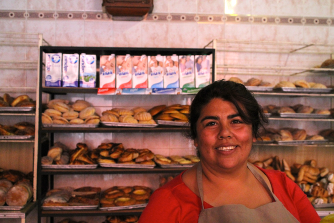As published by SanMiguelRealEstate.com, there are some facts you need to know before feeling adventurous enough to try the street food in San Miguel de Allende. With this guide you will learn how to identify the stands that are safe to visit.
Any discussion about eating in San Miguel should definitely include a few words about what particular foods are served when.
While the word breakfast(desayuno) in Spanish means to break the fast, just as it does in English, and while lots of families eat cereal, juice and toast at this time, it’s also just as common to eat a tamale, eggs, beans and tortillas or even enchiladas as your first meal of the day.
That’s why you’ll need to head to the tamale stand first thing in the morning if you want to get there before they run out (as I strongly suggest you do).
Dinner (la cena) at home is often a light meal, and traditionally included “sweet bread” (pan dulce). To get some of that sweet bread for yourself, head to a panaderia (bread store) during the hours of 8-11am and 5-9 pm, and you’re likely to find it open, although many bakeries are open in the afternoon as well.
And consider yourself warned – going out to dinner with your Mexican friends will feel more like a midnight snack. Dinner frequently isn’t scheduled until 9, or even 10 pm. And don’t try to get any of those delicious little tacos on the street before 7pm. – it just aint’ gonna happen.
Eating on the Street
Is it safe to eat “street” food? Well, how adventurous are you feeling? How strong is your stomach? How susceptible are you to intestinal problems? How hungry are you? In general, cooked food is safer than raw food, although I have not done any kind of blind tests on this claim.
In any case, street food is the closest thing to Mexican fast food you will find in San Miguel and it’s all pretty delicious. What follows is my experience of the most common foods sold on the street. Keep in mind that generally speaking, none of these vendors speak English, so unless you already speak Spanish, be bold, point a lot, and smile widely.
The Tamale Stand
You can recognize tamale stands by the very tall, cylindrical metal pots which are loaded with warm tamales. Popular tamales flavors are “rojo” (red), which are usually made with pork, and “verde”(green), which are usually made with chicken. Sometimes vendors will have “sweet” tamales made with pineapple and sweetened masa (the bread-ish part). I’ve never actually eaten a bad tamale, although some are better than others.
There’s also usually something like a giant soup pot or two, which contain atole, a traditional drink made with chocolate or vanilla flavored corn starch and/or corn flour (masa). Allow me to digress momentarily about the chocolateatole.
Just as there are Spanish cognates (words that sound alike in English and Spanish but don’t necessary mean the same thing), there are also Mexican food cognates, foods which you think you recognize, but really, you don’t. Trust me. Chocolate atole is one of these. You will swear it must be hot chocolate until you take a big swig and then you will want to spit it out. Instead, take a small sip, expecting a very thick, hot drink with something like a whiff of chocolate, and eventually you will acquire a taste for it, and perhaps even a hankering.
The Gorditas Ladies
In the afternoon (and evening) you will likely happen upon a lady cooking gorditas and corn on the cob (elote) on a large comal that looks something like a giant wok. A gordita is kind of like the Mexican version of a pita bread sandwich, the “bread” being made out of a cornmeal-like masa and the fillings, or guisados, previously cooked combinations of meat and vegetables, often housed in that ubiquitous blue speckled kitchenware.
The cook will fry the dough and then fill it with your choice of guisado.
Another Mexican food cognate is the corn on the cob sold on the street. Don’t be expecting sweet, juicy roasted corn – this strain of corn is much starchier and less sweet than other varieties – think tiny baked potato bits on a stick.
The Fruit Stand
It’s hard to miss the fruit stand, the seller wielding his giant machete, whacking open juicy watermelons and fragrant coconuts. It looks SO good, doesn’t it? Especially on those scorching May days, who can resist a plastic container of mixed fruit?I can.
After getting typhoid three times, I don’t even look at that cantaloupe. How do you get typhoid, you ask? It’s gross, but I will tell you, because you need to know. It comes from human feces, either left over on the hands of that guy at the stand who wiped and then didn’t wash, or from little bits that have detached themselves from their mother poop deposited in an open field somewhere and are now blowing around in that dry air.
So, if you must eat raw food on the street, don’t do it in April and May, the hottest, driest season of the year! Wait until the rainy season when those microscopic pieces of poo are no longer wafting through the air and landing on your melon.
To read full article click here


